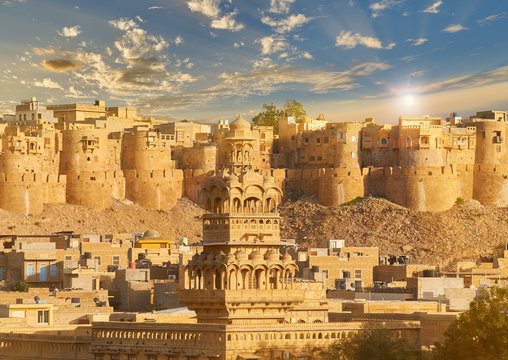Jaisalmer, known as the “Golden City,” is a testament to the magnificence of human ingenuity and the timeless beauty of nature. This enchanting city, nestled in the heart of Rajasthan’s Thar Desert, is renowned for its intricate sandstone architecture that gleams with a golden hue under the desert sun. The unique craftsmanship and historical significance of Jaisalmer’s architecture make it a fascinating destination for travelers and historians alike. In this guide, we will delve into the artistry of Jaisalmer’s sandstone structures and how Rajwada Desert Camp offers a luxurious base to explore these architectural wonders.
The Splendor of Jaisalmer’s Sandstone Architecture
Jaisalmer Fort: The Crown Jewel
Jaisalmer Fort, also known as Sonar Quila or the Golden Fort, stands majestically atop Trikuta Hill, dominating the skyline of Jaisalmer. Built in 1156 AD by Rawal Jaisal, the fort is a UNESCO World Heritage Site and one of the largest fully preserved fortified cities in the world. The fort’s massive walls, intricately carved with fine details, showcase the architectural prowess of the Rajput artisans. Within its walls, you’ll find palaces, temples, and havelis, all adorned with delicate latticework, sculpted pillars, and ornate balconies.
Patwon Ki Haveli: A Masterpiece of Craftsmanship
Patwon Ki Haveli is a cluster of five havelis, each a marvel of intricate sandstone carvings and ornate facades. Constructed in the early 19th century by Guman Chand Patwa, a wealthy trader, these havelis reflect the opulence and artistic sensibilities of their time. The intricate jharokhas (overhanging enclosed balconies), elaborate facades, and detailed frescoes make Patwon Ki Haveli a must-visit for architecture enthusiasts.
Nathmal Ki Haveli: A Blend of Art and Architecture
Nathmal Ki Haveli, built by two architect brothers in the 19th century, is an extraordinary example of architectural symmetry and artistry. Interestingly, each brother worked on one half of the haveli independently, resulting in a perfect blend of two distinct styles. The haveli is adorned with beautiful carvings, including elephants, flowers, and birds, showcasing the detailed craftsmanship of the artisans.
Salim Singh Ki Haveli: An Architectural Wonder
Salim Singh Ki Haveli, with its distinctive peacock-shaped roof and exquisite stone carvings, is another architectural gem in Jaisalmer. Built in the early 18th century by Salim Singh, the prime minister of Jaisalmer, this haveli stands out with its unique design and ornate decorations. The haveli’s elegant arches and intricate detailing reflect the grandeur of Jaisalmer’s architectural heritage.
Experiencing Jaisalmer with Rajwada Desert Camp
Luxurious Swiss Tents
To truly immerse yourself in the beauty of Jaisalmer’s architecture, consider staying in a Swiss tent in Jaisalmer at Rajwada Desert Camp. These luxurious tents offer a perfect blend of modern comforts and traditional charm, providing a unique and comfortable stay in the heart of the desert. Each tent is well-appointed with cozy bedding, en-suite bathrooms, and elegant furnishings, ensuring a memorable experience.
Guided Tours of Architectural Marvels
Rajwada Desert Camp offers guided tours that take you through the intricate alleyways and stunning sandstone structures of Jaisalmer. Knowledgeable guides provide insights into the historical significance and architectural details of the city’s landmarks, enriching your understanding and appreciation of Jaisalmer’s heritage.
Cultural Immersion and Activities
Beyond exploring the architectural wonders, Rajwada Desert Camp offers a range of activities that allow guests to experience the vibrant culture of Rajasthan. From traditional Rajasthani music and dance performances to camel safaris across the golden dunes, the camp ensures that your stay is filled with unforgettable moments.
Exquisite Dining Under the Stars
Dining at Rajwada Desert Camp is an experience in itself. The camp offers delectable Rajasthani cuisine prepared with fresh, locally sourced ingredients. Guests can enjoy their meals in a communal dining area or opt for a private dinner under the stars, surrounded by the serene beauty of the desert.
Planning Your Visit
Best Time to Explore Jaisalmer
The best time to visit Jaisalmer is between October and March, when the weather is pleasant and ideal for exploring the city’s architectural marvels. During this period, daytime temperatures are comfortable, and the nights are cool, making it perfect for desert camping and sightseeing.
Booking Your Stay
To ensure a seamless and enjoyable experience, it is advisable to book camp in Jaisalmer at Rajwada Desert Camp well in advance. Early booking not only guarantees your accommodation but also allows you to plan your itinerary with ease, ensuring you don’t miss out on any of the city’s highlights.
Conclusion
Jaisalmer’s intricate sandstone architecture is a testament to the artistic genius and cultural richness of Rajasthan. From the grandeur of Jaisalmer Fort to the exquisite details

